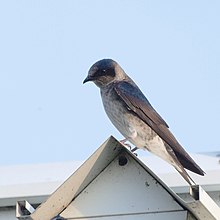Purple martin
| Purple martin | |
|---|---|
 |
|
| Adult male | |
 |
|
| Adult female | |
| Scientific classification | |
| Kingdom: | Animalia |
| Phylum: | Chordata |
| Class: | Aves |
| Order: | Passeriformes |
| Family: | Hirundinidae |
| Genus: | Progne |
| Species: | P. subis |
| Binomial name | |
|
Progne subis (Linnaeus, 1758) |
|
The purple martin (Progne subis) is the largest North American swallow. These aerial acrobats have speed and agility in flight, and when approaching their housing, will dive from the sky at great speeds with their wings tucked.
Purple martins are a kind of swallow, of the genus Progne. Like other members of this genus, they are larger than most of the other swallows. The average length from bill to tail is 20 cm (7.9 in). Adults have a slightly forked tail. Adult males are entirely black with glossy steel blue sheen, the only swallow in North America with such coloration. Adult females are dark on top with some steel blue sheen, and lighter underparts. Subadult females look similar to adult females minus the steel blue sheen and browner on the back. Subadult males look very much like females, but solid black feathers emerge on their chest in a blotchy, random pattern as they molt to their adult plumage.
This species was first described by Linnaeus in his Systema naturae in 1758 as Hirundo subis. The current genus name refers to Procne (Πρόκνη), a mythological girl who was turned into a swallow to save her from her husband. She had killed their son to avenge the rape of her sister. The specific subis is Latin and refers to a type of bird that breaks eagles’ eggs; it may have been applied to this species because of its aggression towards birds of prey when it is nesting.
The species of this genus are very closely related, and some view the purple martin, gray-breasted martin, snowy-bellied martin, and southern martin, as a superspecies.
Purple martins' breeding range is throughout temperate North America. Their breeding habitat is open areas across eastern North America, and also some locations on the west coast from British Columbia to Mexico. Martins make their nests in cavities, either natural or artificial. In many places, humans put up real or artificial hollow gourds, or houses for martins, especially in the east, where purple martins are almost entirely dependent on such structures. As a result, this subspecies typically breeds in colonies located in proximity to people, even within cities and towns. This makes their distribution patchy, as they are usually absent from areas where no nest sites are provided. Western birds often make use of natural cavities such as old woodpecker holes in trees or saguaro cacti.
...
Wikipedia

